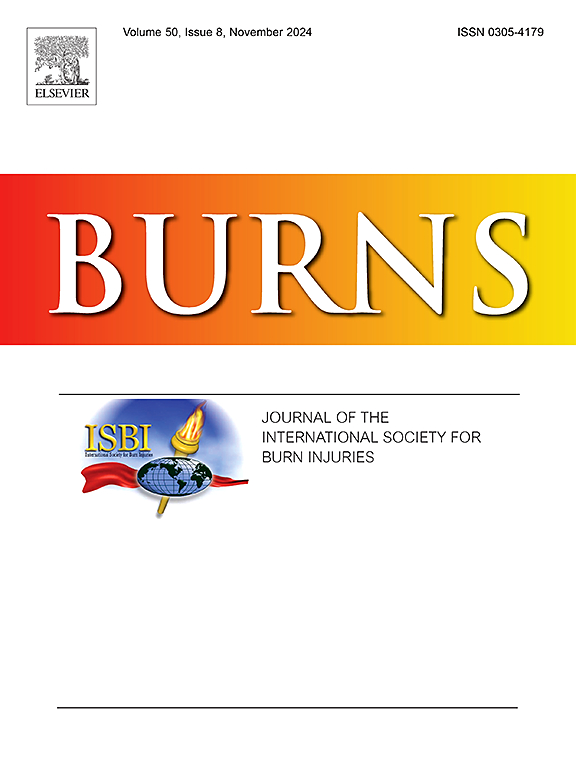光谱成像技术在烧伤深度评估中的应用进展综述
IF 3.2
3区 医学
Q2 CRITICAL CARE MEDICINE
引用次数: 0
摘要
背景:准确的烧伤深度评估对于确定适当的治疗和优化患者预后至关重要。传统的方法,如临床评估和激光多普勒成像,在准确性和及时性方面存在局限性。光谱成像,包括多光谱成像和高光谱成像,已经成为一种有前途的非侵入性方式,以改善烧伤深度评估。本系统综述旨在评估用于烧伤深度评估的光谱成像技术的进展,重点关注诊断准确性、机器学习集成的作用以及当前证据的质量。方法于2024年3月使用PubMed、Scottish Network、EMBASE和Cochrane Library数据库进行综合文献检索。评估光谱成像对烧伤深度评估的研究,并将其与激光多普勒成像、临床评估或组织学分析等标准方法进行比较。使用QUADAS工具评估纳入研究的质量。结果1988 - 2023年有7项研究符合纳入标准,共评估167例患者269个烧伤部位。合并分析显示,联合敏感性为86 %(95 % CI [0.80;0.90]),特异性84 %(95 % CI [0.70;0.93]。然而,该方法的灵敏度范围很大,从61 %到97.2% %,特异性从45 %到100 %。值得注意的是,机器学习的集成,特别是卷积神经网络和支持向量机,提高了分类精度,一些模型的灵敏度和特异性达到了95% %以上。尽管取得了这些令人鼓舞的结果,但研究人员发现,在方法上存在显著差异,而且缺乏标准化的实地事实。结论光谱成像,特别是与机器学习相结合,具有很高的诊断准确性和可重复性,是评估烧伤深度的有效工具。需要进一步的研究来标准化方案,并在不同的患者群体中验证这些技术,为临床采用和改善患者护理铺平道路。本文章由计算机程序翻译,如有差异,请以英文原文为准。
A systematic review of advances in the use of spectral imaging in burn depth assessment
Background
Accurate burn depth assessment is critical for determining appropriate treatment and optimizing patient outcomes. Conventional methods, such as clinical assessment and laser Doppler imaging, have limitations in terms of accuracy and timeliness. Spectral imaging, including multispectral imaging and hyperspectral imaging, has emerged as a promising non-invasive modality to improve burn depth evaluation. This systematic review aims to evaluate the advances in spectral imaging technologies for burn depth assessment, with a focus on diagnostic accuracy, the role of machine learning integration, and the quality of current evidence.
Methods
A comprehensive literature search was conducted in March 2024 using PubMed, Scottish Network, EMBASE, and Cochrane Library databases. Studies that evaluated spectral imaging for burn depth assessment and compared it to standard methods such as laser Doppler imaging, clinical assessment, or histological analysis were included. The quality of the included studies was assessed using the QUADAS tool.
Results
Seven studies from 1988 to 2023 met the inclusion criteria, evaluating a total of 167 patients with 269 burn sites. The pooled analysis revealed a combined sensitivity of 86 % (95 % CI [0.80; 0.90]) and specificity of 84 % (95 % CI [0.70; 0.93]. However, there was a large range of sensitivity identified from 61 % to 97.2 % and specificity from 45 % to 100 %. Notably, the integration of machine learning, particularly convolutional neural networks and support vector machines, improved classification accuracy, with some models achieving over 95 % sensitivity and specificity. Despite these promising results, significant variability in methodologies and a lack of standardized ground truthing were identified.
Conclusion
Spectral imaging, especially when combined with machine learning, shows strong potential as an effective tool for burn depth assessment, offering high diagnostic accuracy and reproducibility. Further research is needed to standardize protocols and validate these technologies across diverse patient populations, paving the way for clinical adoption and improved patient care.
求助全文
通过发布文献求助,成功后即可免费获取论文全文。
去求助
来源期刊

Burns
医学-皮肤病学
CiteScore
4.50
自引率
18.50%
发文量
304
审稿时长
72 days
期刊介绍:
Burns aims to foster the exchange of information among all engaged in preventing and treating the effects of burns. The journal focuses on clinical, scientific and social aspects of these injuries and covers the prevention of the injury, the epidemiology of such injuries and all aspects of treatment including development of new techniques and technologies and verification of existing ones. Regular features include clinical and scientific papers, state of the art reviews and descriptions of burn-care in practice.
Topics covered by Burns include: the effects of smoke on man and animals, their tissues and cells; the responses to and treatment of patients and animals with chemical injuries to the skin; the biological and clinical effects of cold injuries; surgical techniques which are, or may be relevant to the treatment of burned patients during the acute or reconstructive phase following injury; well controlled laboratory studies of the effectiveness of anti-microbial agents on infection and new materials on scarring and healing; inflammatory responses to injury, effectiveness of related agents and other compounds used to modify the physiological and cellular responses to the injury; experimental studies of burns and the outcome of burn wound healing; regenerative medicine concerning the skin.
 求助内容:
求助内容: 应助结果提醒方式:
应助结果提醒方式:


